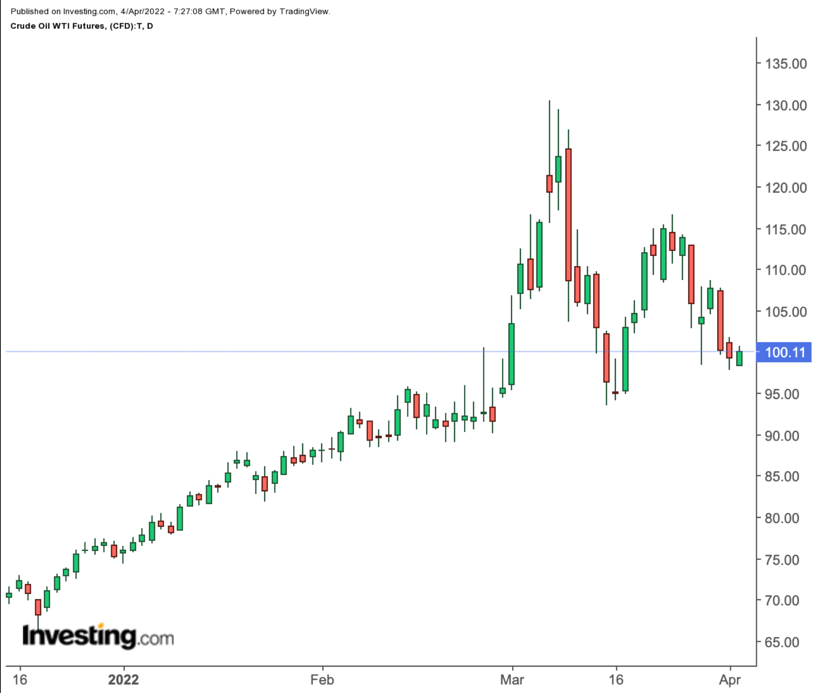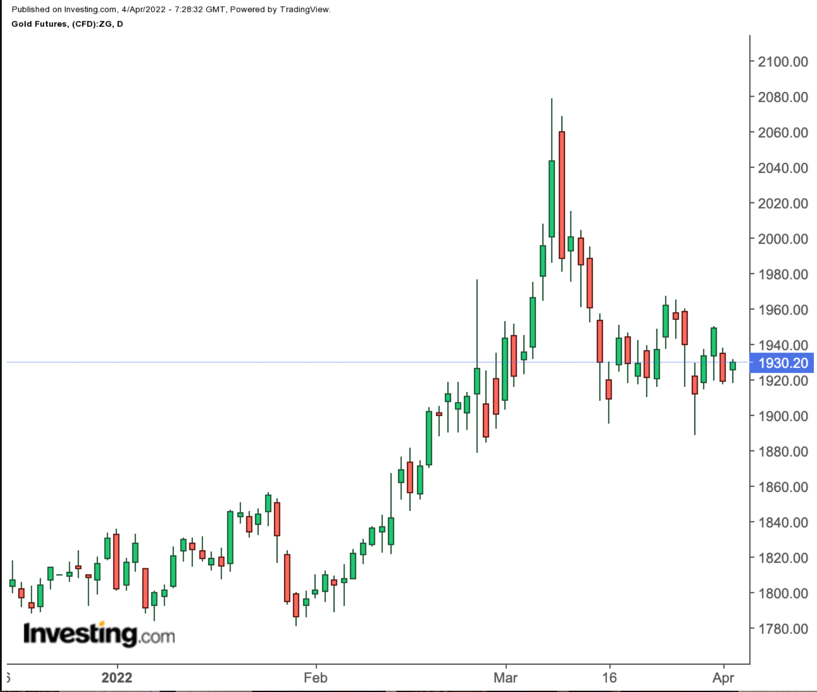A surprise truce to the Yemen war could complicate oil’s rebound from its worst weekly decline in two years, as the pact by Houthi rebels not to attack Saudi oil facilities removes a key geopolitical threat for the market.

In gold’s corner, Wednesday’s release of the Federal Reserve’s March meeting minutes is expected to provide fodder on whether there will be a half-percentage point rate hike in May as traders pore over the central bank’s language.
In Monday’s Asian trading, Brent, the global benchmark for oil, was up 17 just cents, or 0.2%, at $104.56 per barrel by 1:30 PM in Singapore (1:30 AM New York). Brent fell 13% last week to post its biggest weekly decline since April 2020. US crude benchmark West Texas Intermediate (WTI), also took a 13% price dive last week, just like Brent.
Brent and WTI were down more than 1% earlier in the session when they reopened from last week’s tumble, on news that the United Nations has brokered a first-ever two-month truce between a Saudi-led coalition and Iran-aligned Houthis in the seven-year war over Yemen.
The Houthi-Saudi conflict—and constant attacks by the rebels against energy targets in the kingdom—had been “a threat to supply, and a ceasefire would reduce that threat," said Phil Flynn, analyst at Chicago’s Price Futures Group.
Demand concerns in China, the world's top oil importer, also persist as its most populous city Shanghai extends COVID-19 lockdowns. China's transport ministry said it expects a 20% drop in road traffic and a 55% fall in flights during the three-day Qingming holiday due to a flare-up of coronavirus cases there.
Notwithstanding the Yemen peace pact, tougher sanctions planned by the West against major energy exporter, Russia, due to the invasion of Ukraine, could still put a floor under crude prices this week.
Crude’s worst selloff since the outbreak of COVID-19 came last week after President Joseph Biden announced that up to 1 million barrels of oil per day will be released from the US Strategic Petroleum Reserve (SPR) for six months starting in May.
The release, the third in the past six months, will serve as a bridge until domestic producers can boost output and bring supply back into balance with demand.
Biden had earlier ordered the release of 50 million barrels from the SPR in November and 30 million in March, in coordination with the reserves release of other countries like China, Japan, India, South Korea and Britain.
The SPR had 568.3 million barrels in stock as of the week ended Mar. 25, according to the US Energy Information Administration. With 180 million barrels drawn down over six months, the reserve could be down to a third of its current size.
Biden began tapping the SPR last year to provide US refiners with oil loaned from the reserve which they didn't have to pay for, but they had to return it within a stipulated period and with a slight premium. By doing this, the administration hoped there will be fewer transactions of oil in the open market and prices for both crude and fuel products like gasoline and diesel would come down.
In recent weeks, the administration has released some 3 million barrels weekly from the SPR. But the government’s efforts have had a negligible effect on prices thus far, with refiners turning out more products than they usually do at this time of year. That has resulted in an extraordinarily high turnover of barrels that has kept prices little changed on both the crude and oil products fronts.
Members of the International Energy Agency also agreed to release more oil on Friday, joining the 180 million barrels to be released by the United States over the next six months.
"The joint efforts of the US and its allies could temporarily balance off the supply shortfalls in 2022, but it might not be a long-term solution," said Tina Teng, a markets analyst at CMC Markets APAC & Canada in a note.
"Also, the US oil producers may be reluctant for an output increase to keep profit high."
Despite calls from Biden for US energy firms to ramp up production, growth in the domestic rig count remains slow as drillers continue to return cash to shareholders from high crude prices rather than boost production.
On the Fed front, Wednesday’s minutes of the March meeting will give investors an update on how officials view the monetary policy outlook and may also contain more details on plans to shrink the central bank’s $9 trillion balance sheet.
The Fed hiked rates last month by a quarter of a percentage point, the first step in a monetary tightening cycle aimed at curbing inflation, currently at a four-decade high. Since the March meeting several Fed officials, including Chair Jerome Powell, have indicated that they are prepared to hike rates more aggressively to prevent high inflation from becoming entrenched.
Friday’s solid employment report paved the way for a half percentage point rate hike from the Fed at its next meeting on May 4.
Several Fed officials are also due to make appearances during the week, including Fed Governor Lael Brainard, Minneapolis Fed President Neel Kashkari, New York Fed President John Williams and St. Louis Fed President James Bullard.
The United States is also to release factory orders, initial jobless claims, and trade balance data.
Disclaimer: Barani Krishnan uses a range of views outside his own to bring diversity to his analysis of any market. For neutrality, he sometimes presents contrarian views and market variables. He does not hold positions in the commodities and securities he writes about.
